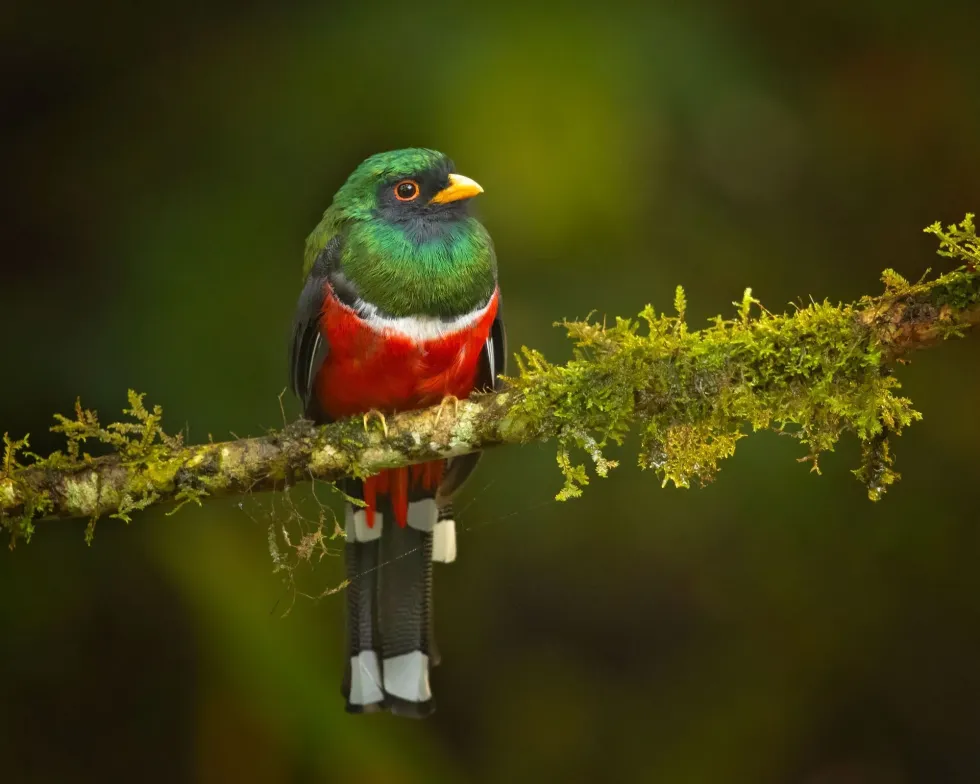The masked trogon, Trogon personatus (Gould, 1842), is 10.6 in (27 cm) long. It is half the size of a red-headed trogon.
The masked trogon (Trogon personatus) is a type of bird that belongs to the Trogon species, consisting of 35 trogon species. The masked trogon belongs to the class Aves, order Trogoniformes, and genus Trogon.
The Trogon personatus is species that is endemic to South American regions like Colombia, Ecuador, Venezuela, the Andes, Peru, and Tepuis. They prefer living in humid and subtropical highlands and forests.
These birds are often found with a number of other subspecies that belong to the Trogonidae family and order Trogoniformes like the personatus masked.
The diet of these birds consists of a variety of fruit and insects. The masked trogon bird of the Trogon genus is a solitary bird.
They are highly protective and possessive of their region and their breeding territory which they proclaim by simple yet loud calls. Their nests are located in a cavity excavated in rotten and decaying wood in a tree or are specially dug by them into a termite nest or wasp nest.
Read on to discover more fun facts about this bird! For more relatable content, check out these blue jay facts and northern gannet facts for kids.
Masked Trogon Interesting Facts
What type of animal is a masked trogon?
The masked trogon, Trogon personatus (Gould, 1842) is a type of common bird that belongs to the Trogon species.
What class of animal does a masked trogon belong to?
The masked trogon (Trogon personatus) belongs to the class of Aves and the order Trogoniformes.
How many masked trogons are there in the world?
There is no substantial data that can account for the current accurate number of masked trogons present in the world. Even though these birds are pretty common, the population is no longer stable as the evidence for any substantial threats is missing. It has been noticed that most birds of the Trogonidae family and subspecies are Endangered.
Where does a masked trogon live?
The Trogon personatus distribution is popularly found in humid subtropical highlands and forests. This trogon species is native to South American regions like Colombia, Ecuador, Venezuela, the Andes, and Tepuis.
What is a masked trogon's habitat?
The Trogon personatus species distribution is endemic to South American regions like Colombia, Ecuador, Venezuela, the Andes, Peru, and Tepuis. They prefer living in humid and subtropical highlands and forests.
These birds are often found with a number of other subspecies that belong to the Trogonidae family and order Trogoniformes like the personatus masked. The diet of these birds of the Trogon genus consists of a variety of fruit and insects. These birds relish hot temperatures.
These birds are very chirpy and happy in nature. They are known for their loud and melodious song.
Who do masked trogons live with?
The Trogon personatus is a species of bird in the family Trogonidae. These birds can be found with several other birds in their range that belong to the order of Trogoniformes and Trogon genus.
However, these birds are solitary and prefer staying alone and not with the company of birds within their range. These birds are not monogamous in nature and do not need a partner bird which is unlike most of the Trogoniformes subspecies. The distribution of these birds is largely found in South Africa.
How long does a masked trogon live?
The masked trogon male and female bird can live for an average of 16 years in the wild and for a period above 18 years in captivity.
How do they reproduce?
The masked trogon (Trogon personatus) bird is a solitary bird. They are highly protective and possessive of their region and their breeding territory which they proclaimed by simple yet loud calls.
Their nests are located in a cavity excavated in rotten and decaying wood in a tree or are specially dug by them into a termite nest or wasp nest.
The female masked trogon bird ideally may lay a clutch of two to four pale whitish colored, clear eggs that are incubated by the male masked trogon (Trogon personatus) as well as the female.
The masked trogon egg hatches after a period of two to three weeks. The chicks are initially taken care of by the male and the female.
What is their conservation status?
These birds of the world have been listed as a species of Least Concern by the IUCN Red List. There has been a steady decline in the number of this species but nothing to be worried about.
Masked Trogon Fun Facts
What do masked trogons look like?
Both the male and the female species of the masked trogon (Trogon personatus) have a soft white barred underside. The tail is a pale white color and the bellies are a bright red color and have a narrow white breast band.
They have a slender back. Adult males can be differentiated from females by their colors. Adult males have shades of iridescent green with soft red orbital skin.
Their bill is a nectarine orange and their face has a black mask. They have cute round heads. Females, on the other hand, are light brown with a vivid black mask and a prominent white ring that encircles the eyes.
Females too have a small cute head but it is smaller than the male head. The female bird is not as large as the male.
How cute are they?
These birds are the prettiest birds of this species. They are smart, beautiful and can sing brilliant songs.
How do they communicate?
The masked trogon, otherwise known as the Trogon personatus, uses one signal in both situations of courtship and predator. This species raises its tail high and then exposes the bright red color in its lower half or underside as a warning sign.
These birds even sing and call to express joy or happiness. Make sure to listen out for their calls if you are ever in countries like Colombia in South America.
How big is a masked trogon?
The masked trogon is 10.6 in (27 cm) long. It is half the size of a red-headed trogon and umbrellabird. These birds are known to be very small but are highly noticeable due to their vibrant colors.
How fast can a masked trogon fly?
The exact speed of the masked trogon, otherwise known as the Trogon personatus, has not been determined. However, it has been noticed that this species does not fly a lot. They prefer to stay in one place or around their nests.
How much does a masked trogon weigh?
The masked trogon weighs only 2 oz (56.7 g). Even though they appear to be quite large in photos, these birds are very lightweight and smaller than elegant trogons.
What are the male and female names of the species?
No specific names have been given to the male or female species of this bird. Both are called trogons or Trogon personatus.
What would you call a baby masked trogon?
The masked trogon baby does not have a specific name. They may be called hatchlings.
What do they eat?
The diet of the Trogon personatus species consists of a variety of fruit, insects, and frogs.
Are they dangerous?
No, this species are absolutely harmless little creatures. They do not possess a threat to any humans in any form. They enjoy staying in the open, chirping around but they do make great pets as well. Most birds that belong to this family and subspecies are harmless.
Would they make a good pet?
Yes, these species make great pets and their conservation status is of Least Concern. However, all birds prefer to stay in the open where they can flutter around and chirp their hearts out so it is always best to let them stay in their natural habitat along with the other birds of the world.
Did you know...
The masked trogon range map is densely distributed only in the northern region of South America.
The Trogon personatus is very popular due to its appearance and performance in a famous Colombian production live show called 'The Birders'. The masked trogon in 'The Birders' is a species that the viewers wait to eagerly take photos of.
There are 35 species in the Trogonidae family.
Do masked trogons migrate?
No, this species of Trogon personatus does not migrate at all, unlike other birds of the world and subspecies. They can be called lazy birds because they prefer to stay close to their territories all year round.
How did the masked trogon get its name?
The term 'trogon' is a Greek word that means 'gnawer,' which refers to the bird's diet. They have an insectivore diet and also its hooked shaped bill. The term 'mask' is added to trogon because of the mask-like feathers around its face.
Here at Kidadl, we have carefully created lots of interesting family-friendly animal facts for everyone to discover! Learn more about some other birds from our aquatic warbler fun facts and glossy ibis fun facts for kids pages.
You can even occupy yourself at home by coloring in one of our free printable Malabar trogon coloring pages.









